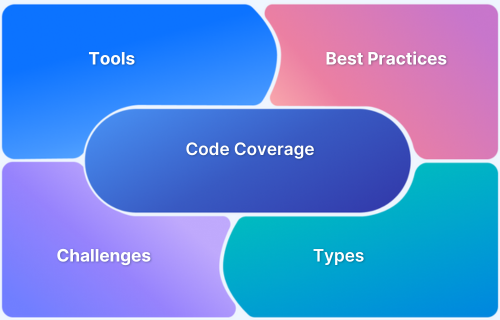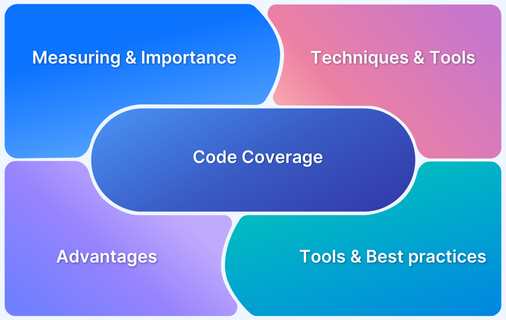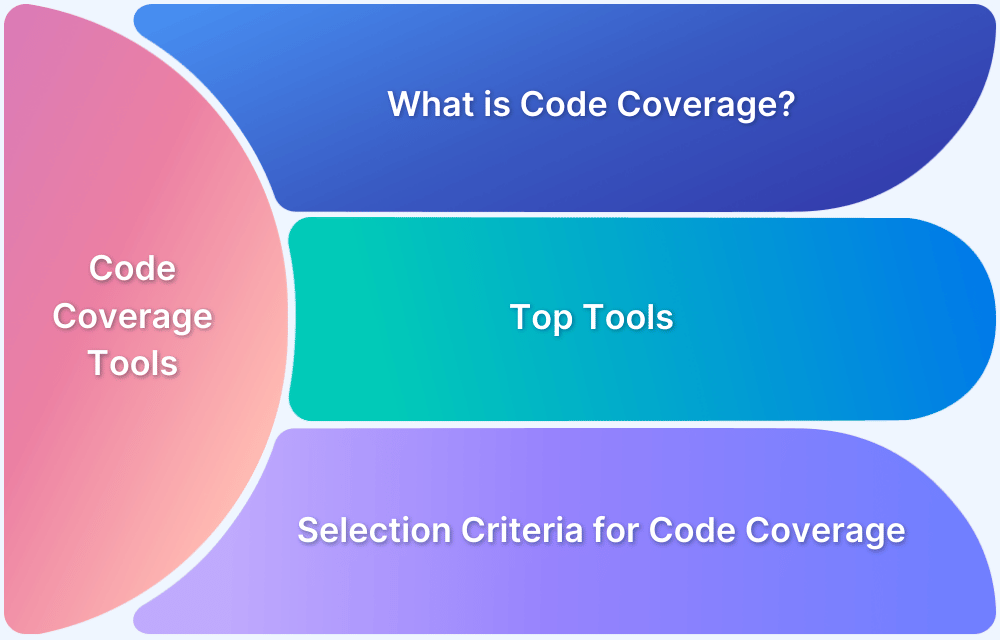In software development testing, code coverage helps determine whether all parts of the code have been tested.
Overview
What is Code Coverage?
Code coverage is a way to measure how much of the application’s code has been executed during testing, providing insights into areas that may need more attention. It is a metric that shows the percentage of source code executed during testing.
How to Measure Code Coverage?
To measure code coverage, a general formula is to calculate the percentage of code that is executed during testing:
Code Coverage (%) = (Number of Code Elements Executed) / (Total Number of Code Elements) * 100
Benefits of Code Coverage
- Enhanced Test Effectiveness
- Improved Code Quality
- Risk Reduction
- Streamlined Debugging
- Better Maintenance
- Compliance Assurance
This article dives into what code coverage means, why it is crucial, how to measure it, and the different types and metrics used to get a complete picture of your code’s health
What is Code Coverage?
Code coverage is a metric that shows the percentage of source code executed during testing.
In simple terms, it’s a way of seeing how much of your code has been “covered” by test cases. By examining which parts of the code are covered, developers and testers can identify untested sections and ensure that critical functionalities have been verified.
Code coverage doesn’t guarantee bug-free code, but it gives a solid indication of code quality and test effectiveness.
Read More: Code Coverage Techniques and Tools
Why is Code Coverage Important?
Code coverage helps improve the quality and reliability of software by making sure tests exercise most parts of the application.
Here are some key reasons why it is essential:
- Early Bug Detection: High coverage helps to identify issues in the early stages of development by reducing the risk of major bugs later.
- Improved Code Quality: Well-tested code tends to be more stable and easier to maintain.
- Better Risk Management: Also, by understanding which parts of the code are untested helps prioritize testing efforts, especially for critical components.
- Increased Confidence in Releases: High code coverage builds confidence that the software works as expected, making it safer to release.
How does Code Coverage work?
Code coverage analyzes which parts of the code are executed during testing. Here’s a step-by-step process on how it functions:
Step 1: Use a code coverage tool to modify the source code by inserting tracking statements to monitor execution.
Step 2: When tests are executed, the tool automatically tracks which parts are executed.
Step 3: The coverage tool logs executed statements, branches, functions, and paths in the codebase.
Step 4: After test execution, the tool compiles data into a detailed report showing covered and uncovered code areas.
Step 5: Developers review the report to identify any issues and to confirm that all important code paths are tested.
Step 6: Finally, code coverage tools can be integrated with CI/CD to track all the improvements over time.
Read More: How to Generate Pytest Code Coverage Report
Code Coverage vs. Test Coverage
Though often used interchangeably, code coverage and test coverage measure slightly different things.
Code coverage focuses on the percentage of code executed in tests, while test coverage considers the percentage of overall features or requirements tested.
Code coverage zeroes in on specific code execution, while test coverage looks at the broader functionality and goals of testing. Both are important, but they serve different purposes in ensuring software quality.
How to Measure Code Coverage?
To measure code coverage, we use a general formula to calculate the percentage of code that is executed during testing:
Code Coverage (%) = (Number of Code Elements Executed) / (Total Number of Code Elements) * 100
This formula provides a high-level view of testing completeness across the codebase. Here, Code Elements may refer to various types, such as lines of code, functions, branches, or statements, depending on the specific type of coverage being measured.
Using this calculation helps developers assess the extent of code that is verified by tests, offering insights into potential gaps that may need additional testing.
Read More: How to enable XCode Code Coverage
Code Coverage Types & Metrics
Code coverage can be broken down into several types, each serving a different purpose in assessing test completeness.
- Line Coverage: Measures the percentage of code lines executed during testing, ensuring that each line of code is tested at least once.
Higher line coverage indicates that more of the codebase has been exercised, reducing the likelihood of untested code hiding potential bugs.
Line Coverage (%) = (Number of Lines Executed) / (Total Lines of Code) * 100 - Function Coverage: This metric measures the percentage of functions in the code that are called & executed at least once during testing. It helps identify untested functions by making sure that core functionalities are covered.
Functional Coverage (%) = (Number of functions called) / (Total number of functions) * 100 - Branch Coverage / Decision Coverage: This metric measures the percentage of decision points that have been tested in the code, like if and switch statements.
It ensures that all possible outcomes (true/false) of each decision are executed at least once, helping identify untested logical branches.
Decision Coverage (%) = (Number of Decisions) / (Branch outcomes) / Total number of decision outcomes in the source code) * 100 - Statement Coverage: This metric measures the percentage of executable statements in the code that have been run during testing.
So, by making sure each line is executed at least once, statement coverage helps identify sections of code that may not be thoroughly tested, reducing the risk of undetected issues.
Statement Coverage (%) = (Number of executed Statements) / (Total number of statements) * 100
- Path Coverage: This metric ensures all possible execution paths within a program are tested at least once.
It checks each unique sequence of statements and branches in the code, which is particularly useful for identifying complex logic errors in highly conditional or branching code.
Path Coverage (%) = (Number of paths Tested) / (Total number of paths) * 100 - Condition Coverage/Expression Coverage: This metric evaluates the percentage of individual boolean expressions within conditional statements that have been executed at least once.
It ensures each boolean operand (such as conditions within if or while statements) is tested for both true and false values, improving test completeness.
Condition Coverage (%) = (Number of executed Operands) / (Total number of operands) * 100 - Loop Coverage: This metric ensures each loop in the program runs at least once and tests boundary conditions, such as entering and exiting the loop.
Validating loop execution paths helps identify errors in repeated processes, particularly in loops with multiple iterations or specific boundary requirements.
Loop Coverage (%) = (Number of loops executed at all expected boundaries) / (Total number of loops) * 100
Code Coverage Tools
Here are some popular tools for measuring code coverage:
Code Coverage Tools
- JaCoCo
- Istanbul
- Clover
- OpenClover
- Coverage.py
- Codecov
- Cobertura
- Bullseye Coverage
- Jenkins
- JaCoCo: A Java-based tool that provides detailed reports and insights into code coverage for Java applications.
- Istanbul: A JavaScript coverage tool often used with Jest that offers code coverage for front-end applications.
- Clover: This tool integrates with IDEs to offer test coverage analysis that supports languages like Java and Groovy.
- Coverage.py: Python’s go-to tool for measuring code execution and coverage statistics, commonly integrated with testing frameworks.
- Codecov: A cloud-based tool that visualizes coverage data across languages and integrates with CI/CD pipelines.
- Cobertura: Cobertura is a free code coverage tool for Java applications, supporting multiple coverage metrics and generating reports in formats like HTML and XML.
- OpenClover: OpenClover is an open-source code coverage tool for Java and Groovy, based on the Clover tool. It offers rich reporting, including method, statement, and branch coverage, and integrates with various build tools and IDEs to identify untested parts of the codebase.
- Bullseye Coverage: Bullseye Coverage is an advanced code converge tool designed for C and C++ programs that provides precise coverage analysis. It integrates with various development environments and supports multiple platforms, offering detailed reports.
- Jenkins: Jenkins is a code coverage open-source tool. It aims to provide continuous integration to deliver your software consistently. It’s written in Java.
Refer to this article for a more extensive guide on code coverage tools.
Benefits of Code Coverage
Some notable benefits of code coverage include:
- Enhanced Test Effectiveness: Code coverage highlights untested areas, enabling teams to design more targeted and effective tests.
- Improved Code Quality: Higher coverage ensures more of the code is exercised, leading to fewer bugs and greater reliability.
- Risk Reduction: Identifying untested areas helps prioritize testing efforts for critical or high-risk functionalities.
- Streamlined Debugging: Thoroughly tested code reduces the chance of runtime errors, simplifying debugging processes.
- Better Maintenance: Highlights unused or redundant code, making it easier to maintain a clean codebase.
- Compliance Assurance: Helps meet industry standards by ensuring sufficient testing of the codebase.
- Confidence in Deployment: Thorough testing coverage minimizes risks, increasing confidence during releases and updates.
Read More: Code Coverage vs Test Coverage
Challenges in Code Coverage
Some of the challenges of code coverage include:
- Incomplete Testing Scope: High coverage doesn’t guarantee all edge cases or scenarios are tested, leading to potential gaps.
- Overhead in Maintenance: Maintaining test cases to keep up with frequent code changes can be time-consuming.
- False Sense of Security: Achieving high coverage can create an illusion of quality, even if tests are not meaningful or thorough.
- Difficulty with Dynamic Code: Certain dynamic or runtime-generated code may not be easily testable, reducing coverage accuracy.
- Limited Insights for Non-Executable Code: Non-functional requirements like security, performance, or usability aren’t addressed by code coverage.
- Resource Intensive: Achieving and analyzing high code coverage often requires significant time, tools, and effort.
- Testing Dead Code: Coverage tools may include unused or obsolete code, inflating metrics and skewing results.
Read More: How to Generate Pytest Code Coverage Report
Best Practices for Code Coverage
Some of the best practices that can be followed are:
- Set Realistic Coverage Goals: Aim for meaningful coverage levels (for example, 70-90%) without obsessing over 100%.
- Focus on Critical Code: Prioritize testing for critical paths and high-risk areas to maximize impact.
- Combine Coverage with Test Quality: Ensure tests are meaningful and cover edge cases, not just achieving metrics.
- Use Multiple Coverage Metrics: Leverage branch, statement, and condition coverage for a comprehensive view.
- Automate Testing: Integrate automated testing into CI/CD pipelines for consistent coverage tracking.
- Review and Refactor Tests Regularly: Update tests as the code evolves to maintain relevance and effectiveness.
- Track Coverage Trends: Monitor coverage over time to identify regressions and improvements.
- Avoid Dead Code Testing: Remove or exclude unused code to ensure coverage metrics reflect active functionality.
- Leverage Coverage Tools: Use tools like JaCoCo, Istanbul, or Clover to generate actionable reports.
- Balance Coverage and Performance: Avoid over-testing trivial code; focus on areas that matter for quality and reliability.
Read More: How to enable Xcode Code Coverage?
Conclusion
Code coverage is a vital metric for assessing the effectiveness of your testing efforts. It ensures that critical parts of your codebase are thoroughly exercised. While it provides valuable insights into untested areas, achieving high-quality software requires more than just code coverage. Pairing it with robust testing and quality assurance practices is essential for building reliable, maintainable applications.
After determining code coverage, maintaining software quality is the next critical step. BrowserStack Code Quality helps you go beyond coverage metrics by providing actionable insights into test performance, functionality, and stability. With seamless integrations, real-time reporting, and advanced analytics, it ensures your code meets the highest standards, delivering software users can trust.





